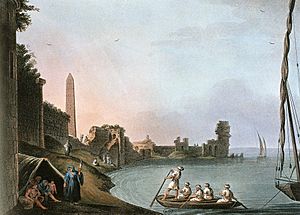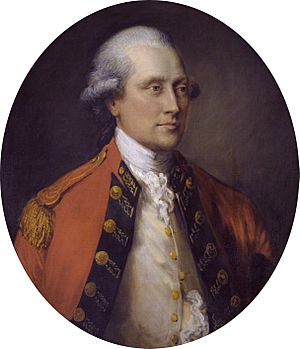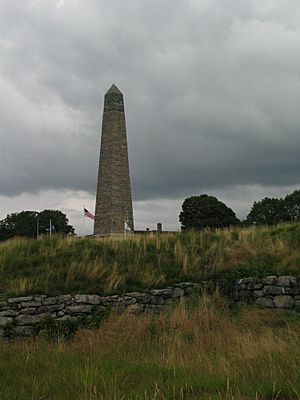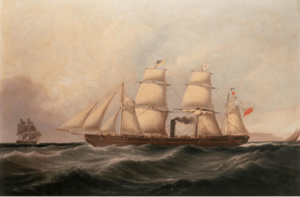54th (West Norfolk) Regiment of Foot facts for kids
Quick facts for kids 54th (West Norfolk) Regiment of Foot |
|
|---|---|
| Active | 1755–1881 |
| Country | |
| Branch | |
| Type | Infantry |
| Size | One battalion (two battalions 1800–1802) |
| Garrison/HQ | Normanton Barracks, Derbyshire |
| Nickname(s) | The Popinjays The Flamers |
| Engagements | American Revolutionary War French Revolutionary Wars Napoleonic Wars Fifth Xhosa War First Anglo-Burmese War Indian Rebellion |
The 54th Regiment of Foot was a famous infantry (foot soldier) regiment in the British Army. It was first formed in 1755. For over 100 years, these soldiers served in many important battles around the world. In 1881, the regiment joined with another group, the 39th (Dorsetshire) Regiment of Foot, to create a new unit called the Dorsetshire Regiment.
Contents
History of the 54th Regiment
How the Regiment Began
The 54th Regiment started in 1755 in a place called Salisbury. It was first known as the 56th Regiment of Foot. A leader named John Campbell, 5th Duke of Argyll helped create it. This was during the Seven Years' War.
In 1756, some other regiments were disbanded. Because of this, the 56th Regiment was re-ranked. It became the 54th Regiment of Foot. The soldiers were sent to Gibraltar in 1756. They stayed there for nine years. Then, in 1765, they moved to Ireland.
Fighting in the American Revolution
In 1776, the regiment traveled to North America. They were there to fight in the American Revolutionary War. Their first battle was at Sullivan's Island in June 1776. After that, they fought in the Battle of Long Island in August 1776. They also took part in the Battle of Rhode Island in August 1778.
In May 1778, about 100 soldiers from the 54th Regiment went on a mission. They used boats to attack sawmills in Fall River, Massachusetts. A ship called Pigot was supposed to help. But Pigot got stuck. The soldiers went ahead with the attack anyway. They fought a quick battle. They managed to destroy mills and other supplies. They lost two soldiers and had five wounded. The Pigot later got free.
In July 1779, the regiment joined a larger force. This group of 2,600 men raided towns in Connecticut. These towns included New Haven, Fairfield, and Norwalk. The 54th Regiment was part of the first group of attackers. They landed at West Haven on July 5. They faced local fighters on their way to New Haven. The 54th Regiment had some losses there. They had soldiers killed, wounded, and missing. The next day, they went back to their ships.
At Fairfield, the 54th Regiment did not go ashore. There were not enough boats for everyone. On July 12, at Norwalk, the 54th led the attack. They bravely pushed back the rebels from Drummond Hill.
The regiment later attacked Fort Griswold in Groton, Connecticut. This was during the Battle of Groton Heights in September 1781. After the battle, the regiment returned home in 1781. They were then given a special name. They became the 54th (West Norfolk) Regiment of Foot in 1782.
Battles During the Napoleonic Wars

In June 1794, the regiment went to Flanders. They fought in the French Revolutionary Wars. They came back to England in 1795. But they soon sailed to the West Indies. There, they helped stop a rebellion on Saint Vincent in 1796.
In May 1800, a second group of soldiers was added. This made the regiment stronger. Both groups took part in two failed attacks. One was the Ferrol Expedition in August 1800. The other was an attack on Cádiz in October 1800.
Then, both groups went to Egypt. They served in the French campaign in Egypt and Syria. They fought in the Battle of Abukir in March 1801. They also fought in the Battle of Alexandria that same month. In June 1801, they were part of the Siege of Cairo. The first group also fought in the Siege of Alexandria. They faced strong resistance at Fort Marabout in August 1801. But they successfully captured the fort.
In May 1802, the two groups joined back together. The regiment then moved to Gibraltar in 1803.
In 1807, the regiment went on the Second invasion of the River Plate. This was led by Sir Samuel Auchmuty. They fought in the Battle of Montevideo in February 1807. They also fought in the Second Battle of Buenos Aires in July 1807. The regiment was sent to Stralsund in 1810. They stayed there until the Battle of Waterloo in June 1815. Their only action at Waterloo was capturing Cambrai after the main battle.
The regiment went to South Africa in 1819. They served in the Fifth Xhosa War. In 1822, they moved to India. Then, in 1824, they went to Burma. They fought in the First Anglo-Burmese War. They were part of an army that moved up the River Irrawaddy. They went all the way to the Kingdom of Ava. They returned to India in 1825. In 1840, they sailed back to England.
The Brave Voyage of the SS Sarah Sands
In 1857, the regiment was sent to India. This was during the Indian Rebellion. About 350 soldiers and five women from the regiment were on a ship. It was called SS Sarah Sands. This was an early type of iron steamship.
On November 11, 1857, a fire broke out on the ship. The Sarah Sands was about a thousand miles from land. It was also far from normal shipping routes. Some of the crew left the ship in lifeboats. This left the ship's officers, the remaining crew, and the soldiers to fight the fire. The women were put in a boat for safety.
Two brave men, Private William Wiles and Quartermaster Richard Richmond, risked their lives. They went below deck to save the regiment's flags. These flags were very important to the soldiers.
The fire was very dangerous. There was a lot of gunpowder and ammunition on board. Soldiers worked hard to move explosives away from the fire. But two large barrels of powder could not be moved. Around nine in the evening, the fire burst through the deck. It set the ship's ropes on fire. Soon after, the expected explosion happened. It blew out parts of the ship. Even the back of the ship dipped underwater for a moment.
Even after the explosion, the remaining crew and soldiers kept fighting the fire. They worked all night. By nine the next morning, the fire was under control. But the back of the ship was completely burned out. Even the glass in the windows had melted.
The ship was badly damaged. But the iron structure and special watertight walls helped save it. Soldiers kept one of these walls cool by wetting it with water. This helped stop the fire from spreading. The ship managed to travel nearly a thousand miles to Mauritius. It arrived on November 25. This was amazing, considering the damage and low food and water supplies.
The regiment then went to Calcutta on another ship. The Sarah Sands was repaired enough to sail back to Britain. It was fully repaired and later sailed to Bombay as a sailing ship. However, it ran aground there and was too damaged to be used again. The story of the Sarah Sands showed how strong iron ships could be. It helped people trust iron vessels more. The regiment saw little fighting during the rebellion. They returned to England in 1866. But they were sent back to India in 1871.
Joining Forces: Amalgamation
In the 1870s, the British Army made some changes. These were called the Cardwell Reforms. Single regiments were grouped together. The 54th Regiment was linked with the 95th (Derbyshire) Regiment of Foot. They shared a training base in Derbyshire.
Then, on July 1, 1881, more changes happened. These were the Childers Reforms. The 54th Regiment joined with the 39th (Dorsetshire) Regiment of Foot. Together, they formed a new, larger regiment. This new unit was called the Dorsetshire Regiment. This marked the end of the 54th Regiment as a separate unit.
Battle Honours
Battle honours are special awards. They show where a regiment fought bravely. The 54th Regiment earned these honours:
- Marabout, Egypt
- Second Burmese War: Ava
|




